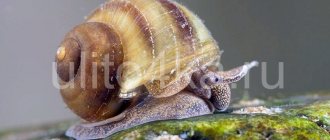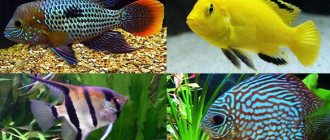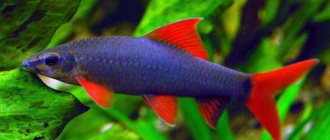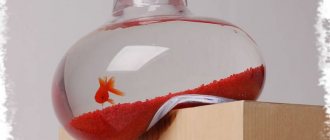This underwater inhabitant cannot be called a rarity - the aquarium snail coil is quite common among aquarists. The mollusk is unpretentious, easy to breed and maintain, and individuals often appear in artificial reservoirs by accident when their eggs or tiny snails end up there along with plants. But, despite the many positive characteristics, keeping these mollusks also has negative aspects, which it is advisable to know about before these pets appear in the aquarium.
General characteristics of coils
Coils are freshwater mollusks that naturally inhabit bodies of water with abundant vegetation and without strong currents. These gastropods have high survivability and are able to live even in very polluted aquatic environments with low oxygen levels. The thing is that mollusks have organs that resemble lungs, thanks to which they can inhale atmospheric air.
Description of the sink
The coils have the appearance of a flattened, twisted spiral. Most often it consists of 4-5 turns, and each turn is thicker than the previous one.
Dimensions of representatives
The maximum diameter of wild mollusks reaches 35 mm, but aquarium snails rarely grow more than 10 mm. Moreover, the larger the family, the smaller its representatives.
Color
The hue varies from brownish to black-red tones, which is associated with the gastropod species. Like other snails, the coil has one leg with a wide, flat base, which the individual uses for movement. The head is decorated with two thin, long horns, which are the organs of touch. They have tiny beady eyes at their tips.
The coils have one feature - an air bubble located in the shell, thanks to which they are able to move on the water surface, turning the shell down. If the mollusk senses danger, it, using a bubble, begins to fall to the bottom.
general description
Coils are pulmonate gastropods that live in freshwater. In nature, they are found in open water bodies with moderate currents. In this case, there should be a lot of living plants.
Reel – aquarium snail
Survivability deserves attention. Gastropods survive in any conditions. Even the most aggressive ones. They are able to extract oxygen from water and air. Temperature does not affect life activity. Under unfavorable conditions they hibernate.
Appearance
The shell resembles a spiral. The maximum number of curls is 8 pcs. The curls vary in thickness. The shells are almost transparent. If you look closely, you can see the structure of the body.
Gastropods survive in any conditions
Gastropods pre-stock up on air. It is used to rise to the surface of the water or descend to the bottom. Depending on the type they differ in shade. The color varies from red to brown. Adults grow up to 1-4 cm.
The shell resembles a spiral
They walk on flat feet. They crawl slowly, quite smoothly. Gastropods do not move on the surface of the water. To do this, little mucus is secreted. Breathing involves the lungs. They are located inside the shell. They take up all the free space. On the surface of the head there is a pair of horns.
Habitat
In nature, gastropods are found throughout the planet. Can be found in open shallow water bodies, swamps, lakes, and slow-flowing rivers. Life expectancy is about 3-4 years. In an aquarium - up to 2 years.
Species diversity
There are several types of mollusks that have both some external similarities and differences:
- Horny
They live in well-overgrown reservoirs with stagnant water. The size of individuals reaches 3.5 cm. The shells are brownish in color, the body is a matching reddish-brown. Horny gastropods eat the remains of various foods that settle to the bottom. - Horny reds
Representatives of the species are small in size; even in nature, individuals do not grow more than 2 cm. They have a bright red shell, which looks beautiful against the background of plants, so you can keep these snails as decoration for a pond. In addition, these mollusks are excellent tank cleaners. - Far Eastern
This little East Asian guest, whose size does not exceed 1 cm, like other coils, is unpretentious. It has a red-brown shell with 5-6 curls. Its main diet is plants. - Keeled
The most common type of snail, more often than other snails, is found in domestic ponds. It often settles and takes root on its own, penetrating the aquarium on plant leaves and with particles of soil material. Individuals are painted in gray-brown tones. The main feature of keeled snails is that the width of their shell is much smaller than the diameter - with a width of 4 mm, the shell consists of 6-7 whorls and its diameter is about 2 cm. Like other coils, they search for food at the bottom, eat algae that covers the walls of the tank. - Wrapped
These mollusks are considered pests - their population increases exponentially, literally filling the container, damaging the biobalance, worsening the condition of the aquatic environment and soil. Individuals have a strong shell of a yellow, dirty hue, their size does not exceed 1 cm.
Are there living conditions requirements?
Coils are not particularly demanding of the environment. Despite the fact that in nature they live happily in polluted reservoirs with stagnant water of various temperatures, having adapted to indoor aquariums, the optimal water temperature for them has become within 22-28 ° C, without additional aeration and filtration.
The lack of requirements for saturating water with oxygen is also explained by the fact that the coils can breathe oxygen from the air. Periodically, they float to the surface and swallow it from above the aquarium space.
Snails love calm, non-moving water. They crawl freely along the bottom or walls of the aquarium, picking up leftover food and fallen rotten leaves.
They do not dig up the soil; they show indifference to the roots of plants. They live in the bottom space, if you exclude floating to the top. Omnivorous and harmless. Not hunters, not capable of aggression, they easily get along with small, peace-loving fish.
A calm character is evident from the moment it enters the aquarium. Sometimes it is invisible. The aquarist himself sometimes wonders how his aquarium was filled with such numerous small guests? And they can arrive in the form of small newborn snails stuck in the roots of transplanted plants or together with the replaced soil.
They reproduce quickly and easily, especially if there is a lot of food. It is not necessary to carefully care for them. Their brightly colored or spotted house against the background of green algae looks beautiful and a little mysterious.
The benefits of coils
As already noted, coils most often end up as uninvited guests in the aquarium, but many owners do not get rid of them, deciding that they do more good than harm, and there is a rational grain in this:
- Reels are an excellent decorative decoration for the artificial underwater world - they complement the decor and enliven the familiar picture.
- These snails do an excellent job as orderlies - they clean the walls of the container from plaque, eat up rotten vegetation without affecting healthy parts. In addition, they carefully examine the bottom, leaving no food particles that can rot and spoil the water. And one more thing - they remove film from the surface of the water.
- Coils, like many shellfish, are real indicators of water, signaling the presence of pollution - it is worth starting cleaning if the number of these inhabitants has noticeably increased.
Some aquarists breed reels for another purpose - they use them to feed other aquarium inhabitants, for example, fish. And since no special conditions are required to replenish the population, it can be done without much difficulty.
Subspecies
- Horny coil - in its natural environment it lives in stagnant water in a cluster of thickets. It has a brown shell color and can grow to a size of 3-4 cm. The body is the same color as the shell. The preferred food is rotten plants on the bottom and uneaten fish food.
- Red horn coils - differs from the previous subspecies by the presence of a bright red shell and half the size. An excellent nurse. Thanks to its bright appearance, it looks impressive against green vegetation.
- The Far Eastern coil is one of the smallest representatives of the species, measuring only 1 cm. Otherwise, it does not differ from previous subspecies. It was brought to us from the East.
- Keelevataya reel is the most common subspecies. Usually gets into the aquarium with vegetation or substrate. It has a medium size, about 2 cm and is light brown in color.
What is the harm of coils?
No matter how useful they are, many aquarists still immediately get rid of such uninvited guests... What is the reason for this reaction?
- Due to the fertility of mollusks. Coils are hermaphrodites, which do not require a pair to produce offspring, which means that each individual begins to reproduce, and does so countless times. If you do not control this process, then soon the remaining inhabitants will become crowded, and the water will be filled with the waste products of these creatures.
- In a cramped aquarium, where a great many mollusks live, food becomes difficult. But the coils do not get lost and begin to eat all the vegetation, getting to the healthy parts.
- These snails can cause fish diseases. For example, wild shellfish placed in a home aquarium can be carriers of all sorts of infections and parasites. And when treating fish, the coils will die; they do not tolerate most medications well.
- A large family of snails will not decorate the appearance of a pond, since entire clusters of them begin to hang on all more or less suitable surfaces.
Truths and myths about reels
Very often, articles about coil snails contain a lot of contradictory information, including negative information.
Coils multiply unregulatedly . Indeed, the mollusk population can grow quickly, but only if they have no natural enemies in the aquarium or the fish are constantly well-fed. And this can be fixed.
Planorbis spoils the green spaces of domestic ponds . Actually this is not true. The mollusk is often seen on a rotten plant, but the reason it is in this place is that it eats this very decomposed part of the plant. The snail is unable to pierce a healthy leaf, since it has naturally weak teeth.
Coil snails carry parasites that infect and sometimes kill aquarium fish. Hypothetically, this is possible, but it is much more likely to introduce parasites with food (especially live food from a nearby body of water). Therefore, you just need to buy safe reels in a specialized store.
In conclusion, I would like to note the following in defense of snails: whether to keep coils in a home aquarium or not, everyone decides for themselves, but the benefits of these nurse mollusks are obvious, and all the inconveniences associated with them can be minimized.
AMPULAR CONTENTS REPRODUCTION COMPATIBILITY PHOTO DESCRIPTION.
Features of keeping coil snails
In captivity, these inhabitants live from 2 to 4 years, but more often their life cycle does not exceed 2 years. There are no special requirements for their content, except that it is worth considering the following nuances:
- the most suitable temperature of the aquatic environment is 22°-28°C, although these gastropods tolerate changes well;
- the bodies of snails consist of protein components, and when they die, the decomposition process occurs very intensively, this spoils the water, so the dead inhabitants should be removed immediately;
- an aquarium with coils must be equipped with a lid, otherwise these inhabitants will periodically run away and die;
- Mollusks do not require special nutrition - they eat leftover fish food and rotting greens; in addition, they can be treated to pieces of vegetables.
Nutrition
The snail coil, the benefit of which is the destruction of dead or rotted algae, will never harm living vegetation. Mollusks of this species have teeth that are not strong enough to gnaw through the leaves of healthy aquarium plants.
With pleasure, mollusks feast on leftover food intended for fish or special pressed tablets for catfish. Plaque on walls and decorative objects is also a favorite food for coils. Mollusks of this species are called aquarium orderlies.
Snails do not need any additional food, but the following feeding can be used:
- cucumber,
- zucchini,
- lettuce leaves,
- spinach,
Just pre-cook the vegetables for a couple of minutes or pour boiling water over them.
Snail breeding process
Like most creatures suffering from hermaphroditism, coils reproduce very intensively, producing numerous offspring. From one or two individuals you can get an entire population, even if you don’t set such a goal. This growing family is usually controlled by the inhabitants who feed on the snails. They prevent them from growing unnecessarily.
Snail eggs look like a transparent film with dots inside. Its specimens are attached to any surface, without particularly hiding it. The shell of the caviar is so strong that other inhabitants cannot feast on it or harm it. 21-28 days after laying, baby snails are born from the eggs.
Photo and video
You can see what different types of coils look like in the photo. If you plan to breed yourself, you can watch the video. From informational videos you can learn how they live, reproduce, and move.
How to get rid of unauthorized inhabitants of an aquarium
If the owner has noticed these gastropods that have come from God knows where, or has introduced them himself and did not calculate the rate of their reproduction, the question arises - how to reduce their number or completely eliminate them?
- Get ancistrus - they can cope with the strong eggs of the reels. And if you start macropods or tetradons, then the number of adult individuals will decrease. True, not all fish can coexist with these inhabitants.
- Buy predatory helen snails - they also eat smaller relatives.
- Remove mollusks manually - lure them with blackened banana peels (cabbage leaves, etc.), and then remove them along with the attached gastropods.
- You can use special products, but it is better to consult a specialist before use.
Reels are controversial aquarium inhabitants that require caution when breeding. But with the right approach, these mollusks are able to perform complex work and delight with their appearance.
Lifestyle and habitat
In nature, reels usually choose shallow freshwater bodies of water for their place of residence, most often with a stagnant or extremely slow current. They live in lakes, ponds, canals, rivers, sometimes even streams.
In such places there is usually a lot of different rotting underwater vegetation. This is where these creatures settle, for example, perching on the leaves of water lilies and egg capsules, most often on their underside. All this serves them as both home and food.
The reservoirs that house the reels can be not only permanent, but also formed only temporarily. And this is not scary for creatures that are able to breathe with their lungs and are able to stay without water for some time. If the reservoir dries out, then such snails bury themselves in mud or silt, completely hide in the shell and seal it securely with the help of a dense film they secrete.
And in this state they are able to exist for about three months in the hope of better times, in anticipation of heavy rains and replenishment of shallow reservoirs. In this case, the body of the mollusks dries out and loses almost half of its mass, but then, if the outcome is favorable, it is restored.
In an aquarium, the coil snail is the most unpretentious resident. There is no need to create special conditions for keeping such creatures. They are little affected by water parameters, the degree of its contamination, the volume of the vessel and temperature changes.
They adapt to new conditions quickly, and therefore even beginners can breed them. But still, if there is a need for the reels to grow and reproduce better and faster, you need to try to create for them conditions similar to those that exist in their natural habitats, or even more favorable.
To do this, you need to take into account the following information.
- The water temperature is not very important for the life of such snails, as long as it is above zero and does not freeze. But still, an environment of approximately +25°C is considered ideal for them, since mostly tropical species of coils settle in aquariums.
- The container where these creatures have taken root should be constantly cleared of dead snails so that their decomposition does not affect the quality of the water. Dead coils can be distinguished from living ones by bloody discharge inside the shell and an unpleasant odor emitted.
- The liquid in the aquarium should be regularly replenished with special preparations that increase the percentage of calcium in the water. The coils are in great need of this substance, which plays a huge role in the formation of shells, and if there is a shortage of it, they can even die.
- It is better to cover the container where such snails live on top with a flat, preferably transparent covering with small holes made there to allow air to penetrate into the container. This is done so that the coils, which suddenly decide to travel, do not decide to go on the run, because these creatures climb on any type of surface just perfectly.
Photo of aquarium snail coils
Reproduction and lifespan
Such mollusks have no gender, or rather, they simultaneously bear both female and male characteristics of an individual, that is, they are considered hermaphrodites. Therefore, the reproduction of the coil snail occurs in almost any environment and unusually quickly, provided, of course, that these creatures are sufficiently mature, that is, they have reached the age of one year.
Although, to be completely precise, coils are capable of self-fertilization, but upon contact with each other they can also mutually exchange genetic material. And representatives of some species do not reproduce in isolation at all.
In nature, these very prolific mollusks leave their eggs glued to the surface of algae or to some other underwater objects. Snails also do this when living in an aquarium, using the walls of the tank and surrounding vegetation. In artificial environments, this process can be carried out without outside participation and occurs easily and quickly, provided there is sufficient nutrition and an acceptable temperature.
The caviar of the coil snail is round in shape, pinkish in color, and quite transparent, which makes it invisible. It is deposited in a gelatinous substance, which ultimately takes the form of a flat, pancake-shaped growth on the leaf. This “cake” has a light brown or yellowish, sometimes slightly different color. In total, large individuals can have up to 70 eggs in their clutch, but small ones have significantly fewer eggs.
The rate of development of eggs depends on the state of the environment, for the most part its temperature indicators. In general, changes happen quickly. Under favorable conditions, two weeks are enough for the egg to form a tiny but rapidly growing snail. The young generation is very viable; young animals are able to move around and eat the same things that adults eat.
The shells of small snails are transparent and thin, and they become stronger as the mollusk itself grows. Such organisms have special glands that extract limestone particles from the water and deposit them along the edge of the mantle of the shell. Thus, growth rings appear on the shells, indicating the age of the organism.
Coils can live in an aquarium for no more than three years. But under natural conditions, even this short period is significantly reduced. And this circumstance is greatly facilitated by the predatory enemies of snails: aquatic birds, small reptiles, amphibians, who eat them with pleasure.











